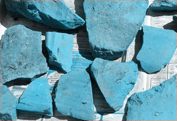New Software - New Format
|
|
As you can see I’ve got some new software. What do you think of the
format? The main problem will be filling the columns. That’s where
you can help. If you have news or anything you want to say, contact me or drop me a line,
anything to do archaeology or history will do.
Next Meeting
The next meeting of the Society will be on Wednesday 5th February at the history shop
at 7.30 pm as usual. This month is the A.G.M. so please bring your annual
subscription i.e. £5. At the meeting we will be showing a video on Egypt
entitled Lost Civilisations kindly lent to us by Mandy Singleton, and once again using
Dave Thomas's projector equipment.
Programme
This year’s program is taking on a distinct Egyptian flavour. As well as
this month's video, in April we have Joanne Fletcher from Manchester University who will
be talking about Amenhotep III. In June we have Stan Ladd talking about Obelisks and
later in the year we hope to have another Egyptologist from the Manchester Exploration
Society. The rest of the year is looking good too. In March Bob Blakeman will be
talking about Medieval Wigan and in May we have Rachael Newman from Lancaster University
who is currently excavating the Roman site at Walton-le-Dale.
Roman Coal Mines
I have been recently reading an article published in the Antiquaries Journal about the
use of coal by the Romans (reviewed in Current Archaeology No.148). In fact,
although coal was used extensively in the Romans period, very little evidence exists about
its extraction at that time. The article is very comprehensive and well researched,
but it does not mention the findings of Edward Hull in the Arley valley in the 19th
century (referred to in Tony France & Donald Anderson's recent book on the Wigan
Coal & Iron Co.). Hull describes peculiar workings that were octagonal or honeycomb in
plan with connecting roads, a hoard of Roman coins proving their antiquity.
'Supposed Roman workings' are also marked on a 1930's geology map of the Arley
valley (but I suspect in the wrong place). Most likely nothing remains of these workings,
but Roman finds in the area may help to add credence to his report
New Mill
At
last month's meeting I presented part of a map given to me by Tony France showing the
Arley Valley dated around 1830. On this map, the Arley Mill is referred to as the
'Blacking Mill'. Tony suggests that in the 1700's before the days of mineral oils, a
mixture of ground charcoal and animal fat was used for high temperature bearing
lubrication. This was called 'blacking', probably the same stuff used on fire
grates. We certainly do have a reference for charcoal ground there in the early 19th
century. There is also shown a 'new' mill building we have not seen before on any other
map. It is referred to as the 'Doughty Mill' and is situated near the footbridge.
Using a computer to superimpose this map onto more modern ones of the same area, it should
be possible for us to locate the site and perhaps some of the old mine-workings marked as
well. A field trip is to be arranged for the end of the month.
Hope to see you at the meeting - B.A.
|



